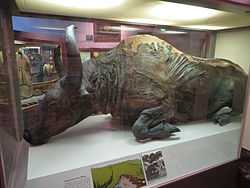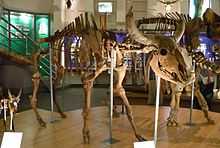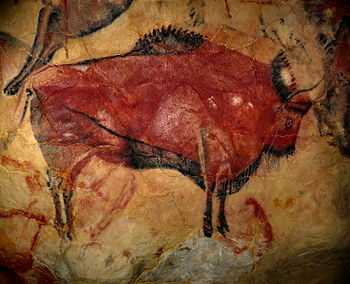Steppe bison
| Steppe bison Temporal range: Irvingtonian to Holocene 1.8–0.009Ma | |
|---|---|
 | |
| "Blue Babe", a mummified specimen from Alaska | |
| Scientific classification | |
| Kingdom: | Animalia |
| Phylum: | Chordata |
| Class: | Mammalia |
| Order: | Artiodactyla |
| Family: | Bovidae |
| Subfamily: | Bovinae |
| Genus: | Bison |
| Species: | †B. priscus |
| Binomial name | |
| †Bison priscus Bojanus, 1827 | |
The steppe bison[1] or steppe wisent (Bison priscus) is an extinct species of bison found on steppes throughout Europe,[2] Central Asia,[3] Beringia, and North America[4] during the Quaternary.
Evolution

It is believed to have evolved somewhere in South Asia, which would have it appearing at roughly the same time and region as the aurochs with which its descendants are sometimes confused.
The steppe bison became extinct in the early Holocene, as it was replaced in Europe by the modern bison species and in America by a sequence of species (first Bison latifrons, and somewhat later, Bison antiquus) culminating in the modern American bison.[5]
The steppe bison was over 2 m tall at the shoulder, and resembled the modern bison species, reaching 900 kg (1984 lb) in weight.[6] The tips of the horns were a meter apart, the horns themselves being over half a meter long.
Discoveries

Steppe bison appear in cave art, notably in the Cave of Altamira and Lascaux, and the carving Bison Licking Insect Bite, and have been found in naturally ice-preserved form.[5][7][8]
Blue Babe is the mummy of a 36,000-year-old male steppe bison which was discovered north of Fairbanks, Alaska, in July 1979.[9] The mummy was noticed by a gold miner who named the mummy Blue Babe - "Babe" for Paul Bunyan's mythical ox, and blue because of the coating of vivianite, a blue iron phosphate, that covered much of the specimen.[10] Blue Babe is also frequently referenced when talking about scientists eating their own specimens: the research team that was preparing it for permanent display in the University of Alaska Museum removed a portion of the mummy's neck, stewed it, and dined on it to celebrate the accomplishment. [11]
In 2011, a 9,300-year-old mummy was found at Yukagir in Siberia.[12]
References
- ↑ Steppe Bison – Yukon Beringia Interpretive Centre. Beringia.com. Retrieved on 2013-05-31.
- ↑ Вестник Кирилло-Белозерского музея 9 (Май 2006) О. Яшина, Т.В. Цветкова – Кирилловский бизон. Kirmuseum.ru. Retrieved on 2013-05-31.
- ↑ Vasiliev, S.K. (2008). "Late pleistocene bison (Bison p. priscus Bojanis, 1827) from the Southeastern part of Western Siberia". Archaeology, Ethnology and Anthropology of Eurasia 34 (2): 34. doi:10.1016/j.aeae.2008.07.004.
- ↑ Zazula, Grant D.; MacKay, Glen; Andrews, Thomas D.; Shapiro, Beth; Letts, Brandon; Broc, Fiona (2009). "A late Pleistocene steppe bison (Bison priscus) partial carcass from Tsiigehtchic, Northwest Territories, Canada". Quaternary Science Reviews 28 (25–26): 2734–2742. doi:10.1016/j.quascirev.2009.06.012.
- ↑ 5.0 5.1 Verkaar, E. L. C.; Nijman, IJ; Beeke, M; Hanekamp, E; Lenstra, JA (2004). "Maternal and Paternal Lineages in Cross-Breeding Bovine Species. Has Wisent a Hybrid Origin?". Molecular Biology and Evolution 21 (7): 1165–70. doi:10.1093/molbev/msh064. PMID 14739241.
- ↑ McPhee, R. D. E. (1999) Extinctions in Near Time: Causes, Contexts, and Consequences, Springer, isbn 0306460920, p. 262.
- ↑ Dale Guthrie, R (1989). "Frozen Fauna of the Mammoth Steppe: The Story of Blue Babe". ISBN 9780226311234.
- ↑ Paglia, C. (2004). "The Magic of Images: Word and Picture in a Media Age". Arion: A Journal of Humanities and the Classics (Trustees of Boston University) 11 (3): 1–22. doi:10.2307/20163935. JSTOR 20163935.
- ↑ Deem, James M. "Blue Babe - the 36,000 year-old male bison" James M. Deem's Mummy Tombs. 1988-2012. Accessed 20 March 2012.
- ↑ Harington, C.M. "Steppe Bison". Yukon Beringia Interpretive Center. March 1996. Accessed 20 March 2012.
- ↑ Dale Guthrie, R (1989). "Frozen Fauna of the Mammoth Steppe: The Story of Blue Babe". p. 298. ISBN 9780226311234.
- ↑ Palermo, Elizabeth (6 November 2014). "9,000-Year-Old Bison Mummy Found Frozen in Time". www.livescience.com. Retrieved 4 December 2014.